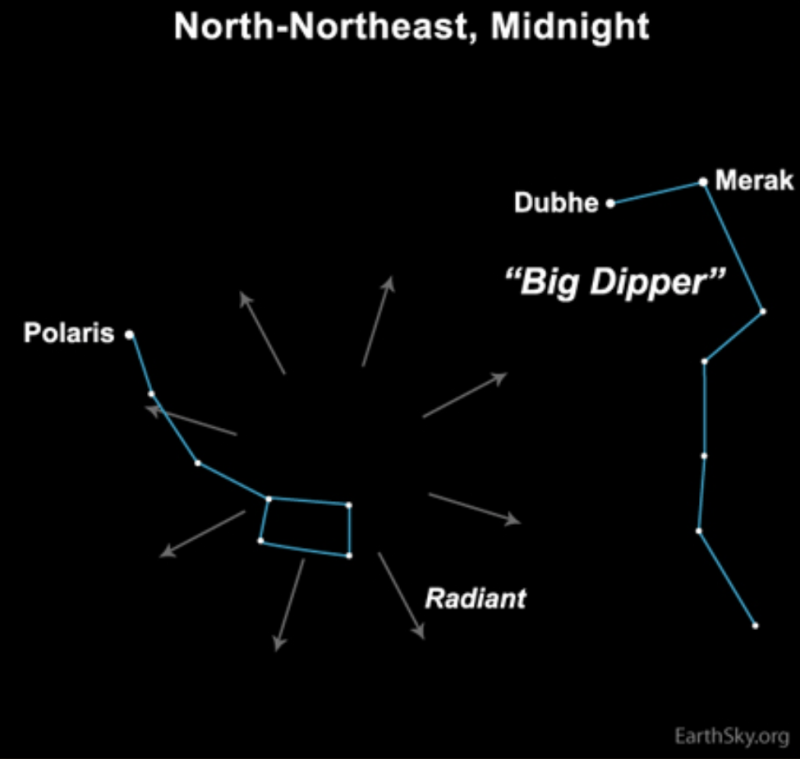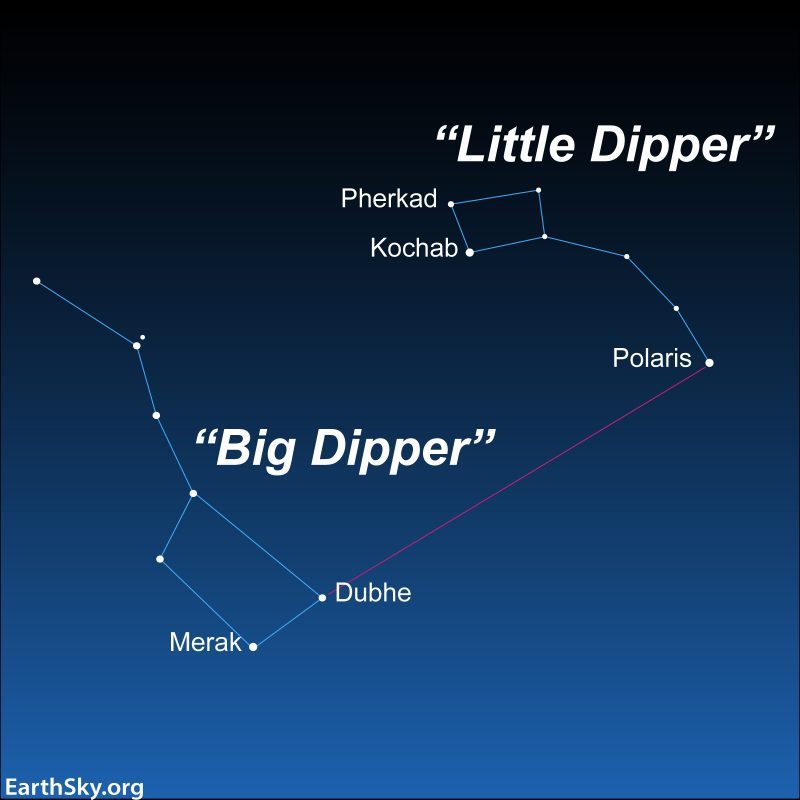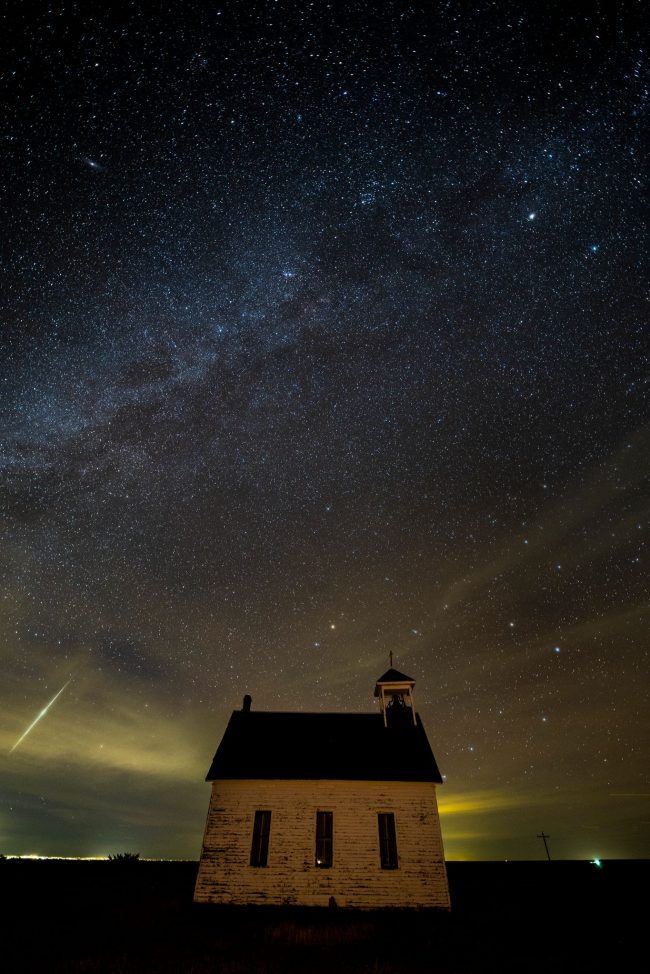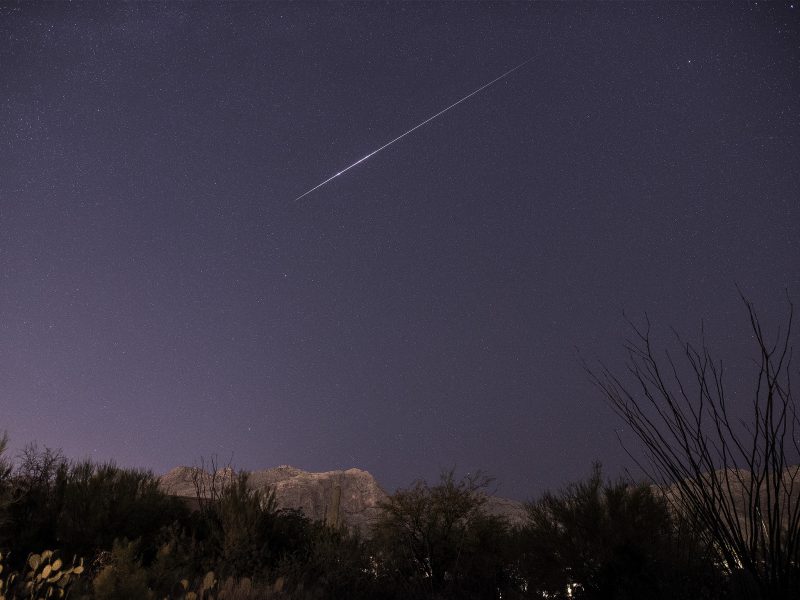
Watching the Ursid meteor shower in 2021
The annual Ursid meteor shower runs from about December 17 to 26 every year. It always peaks around the December solstice, which, in 2021, comes on December 21. The Ursids’ peak is probably the morning of December 22. But, in 2021, the full moon comes on December 18-19. So there will be a bright moon in the morning sky during the Ursids 2021 peak. Still, if past experience is any indication, you might see an Ursid meteor or two streaking along in the moonlight. Here’s what to watch for.
Generally, the Ursids are a low-key affair, offering perhaps as many as five to 10 meteors per hour in a dark sky with no moon. In rare instances, bursts of 100 or more meteors per hour have been observed at times. Those Ursid bursts keep Northern Hemisphere meteor-watchers interested in this shower, despite their peak in the cold of winter.
If you want to try watching the Ursids in 2021, or in any year, a country location is best. Dress warmly! Bring a sleeping bag. And plan to spend several hours reclining under a dark sky free of artificial lights, beginning around the wee morning hours of December 22. Will you see some? It’ll be tough in the moonlight … but maybe!

Ursid meteor shower radiant point
The chart above shows the Big and Little Dipper asterisms – in the constellations Ursa Major and Ursa Minor – for which the Ursid meteor shower is named.
As you may know, all meteors in annual showers have radiant points; the showers typically take their names from the constellations in which their radiants lie. If you trace the paths of the slow-moving Ursid meteors backward, they appear to come from the section of sky marked by the Little Dipper star Kochab.
If you look from a Northern Hemisphere location around the time of the solstice, you’ll find the Big Dipper and the star Kochab well up in the north-northeast at around 1 a.m your local time. That’s about the time of night you’ll want to start watching this meteor shower.
From far-northerly latitudes (for example, in Canada), the Little Dipper is circumpolar (out all night). From there, you’ll find the star Kochab below Polaris, the North Star, at nightfall. Kochab (and all the Little Dipper stars) circle Polaris in a counterclockwise direction throughout the night, with this star reaching its high point for the night in the hours before dawn.
Read more: Kochab and Pherkad guard the North Celestial Pole
Do you love stargazing? Order your EarthSky Planisphere today!

Here’s some Ursid meteor shower history for you
If you decide to watch it, you might enjoy knowing that the Ursids are a relatvely new meteor shower. Some meteor showers, such as the Perseids in August, have been watched each year at the same time for many centuries. The Ursid shower was first observed around the turn of the 20th century, when a skywatcher noticed that some meteors seen around this time of year weren’t random in their direction of motion across our sky’s dome, but instead appeared to radiate from near the star Kochab in the bowl of the Little Dipper asterism.
As the years of the 20th century passed, careful observers looked for, and observed, occasional Ursid outbursts.
Although the Ursid meteor shower has been observed for just over a century – and although rates are typically around 5-10 meteors per hour – the Ursids have gained popularity in recent years because of these possible outbursts.
Bursts of about 100 meteors per hour happened in 1945 and 1986. An unexpected increase of 30 per hour came in 1973.

Not great for the Southern Hemisphere
By the way, the radiant point for the Ursids is just too far north on the sky’s dome to be easily visible from the Southern Hemisphere’s temperate latitudes. The star Kochab – near the Ursids’ radiant point – can’t be seen from there. In other words, for temperate latitudes in the Southern Hemishere, the radiant stays below the horizon. Since the meteors radiate out in all directions from the radiant point, you might see that – from those southerly latitudes – half the meteors or more will never make it above your horizon.
From the Southern Hemisphere, you might see a few Ursids come streaking up from your northern horizon around the time the shower peaks. Or you might see no meteors at all.
Bottom line: If you want to watch the Ursids peak on the morning of December 22, 2021, find a country location where you can camp out. Dress warmly! And plan to spend several hours reclining under a dark sky. The predawn hours are usually the most favorable. Unfortunately, this year, a bright moon is in the way.
EarthSky’s meteor guide for 2022, with December 2021 meteors
The post Ursid meteor shower peaks morning of December 22 first appeared on EarthSky.
from EarthSky https://ift.tt/3yDHBix

Watching the Ursid meteor shower in 2021
The annual Ursid meteor shower runs from about December 17 to 26 every year. It always peaks around the December solstice, which, in 2021, comes on December 21. The Ursids’ peak is probably the morning of December 22. But, in 2021, the full moon comes on December 18-19. So there will be a bright moon in the morning sky during the Ursids 2021 peak. Still, if past experience is any indication, you might see an Ursid meteor or two streaking along in the moonlight. Here’s what to watch for.
Generally, the Ursids are a low-key affair, offering perhaps as many as five to 10 meteors per hour in a dark sky with no moon. In rare instances, bursts of 100 or more meteors per hour have been observed at times. Those Ursid bursts keep Northern Hemisphere meteor-watchers interested in this shower, despite their peak in the cold of winter.
If you want to try watching the Ursids in 2021, or in any year, a country location is best. Dress warmly! Bring a sleeping bag. And plan to spend several hours reclining under a dark sky free of artificial lights, beginning around the wee morning hours of December 22. Will you see some? It’ll be tough in the moonlight … but maybe!

Ursid meteor shower radiant point
The chart above shows the Big and Little Dipper asterisms – in the constellations Ursa Major and Ursa Minor – for which the Ursid meteor shower is named.
As you may know, all meteors in annual showers have radiant points; the showers typically take their names from the constellations in which their radiants lie. If you trace the paths of the slow-moving Ursid meteors backward, they appear to come from the section of sky marked by the Little Dipper star Kochab.
If you look from a Northern Hemisphere location around the time of the solstice, you’ll find the Big Dipper and the star Kochab well up in the north-northeast at around 1 a.m your local time. That’s about the time of night you’ll want to start watching this meteor shower.
From far-northerly latitudes (for example, in Canada), the Little Dipper is circumpolar (out all night). From there, you’ll find the star Kochab below Polaris, the North Star, at nightfall. Kochab (and all the Little Dipper stars) circle Polaris in a counterclockwise direction throughout the night, with this star reaching its high point for the night in the hours before dawn.
Read more: Kochab and Pherkad guard the North Celestial Pole
Do you love stargazing? Order your EarthSky Planisphere today!

Here’s some Ursid meteor shower history for you
If you decide to watch it, you might enjoy knowing that the Ursids are a relatvely new meteor shower. Some meteor showers, such as the Perseids in August, have been watched each year at the same time for many centuries. The Ursid shower was first observed around the turn of the 20th century, when a skywatcher noticed that some meteors seen around this time of year weren’t random in their direction of motion across our sky’s dome, but instead appeared to radiate from near the star Kochab in the bowl of the Little Dipper asterism.
As the years of the 20th century passed, careful observers looked for, and observed, occasional Ursid outbursts.
Although the Ursid meteor shower has been observed for just over a century – and although rates are typically around 5-10 meteors per hour – the Ursids have gained popularity in recent years because of these possible outbursts.
Bursts of about 100 meteors per hour happened in 1945 and 1986. An unexpected increase of 30 per hour came in 1973.

Not great for the Southern Hemisphere
By the way, the radiant point for the Ursids is just too far north on the sky’s dome to be easily visible from the Southern Hemisphere’s temperate latitudes. The star Kochab – near the Ursids’ radiant point – can’t be seen from there. In other words, for temperate latitudes in the Southern Hemishere, the radiant stays below the horizon. Since the meteors radiate out in all directions from the radiant point, you might see that – from those southerly latitudes – half the meteors or more will never make it above your horizon.
From the Southern Hemisphere, you might see a few Ursids come streaking up from your northern horizon around the time the shower peaks. Or you might see no meteors at all.
Bottom line: If you want to watch the Ursids peak on the morning of December 22, 2021, find a country location where you can camp out. Dress warmly! And plan to spend several hours reclining under a dark sky. The predawn hours are usually the most favorable. Unfortunately, this year, a bright moon is in the way.
EarthSky’s meteor guide for 2022, with December 2021 meteors
The post Ursid meteor shower peaks morning of December 22 first appeared on EarthSky.
from EarthSky https://ift.tt/3yDHBix

Aucun commentaire:
Enregistrer un commentaire